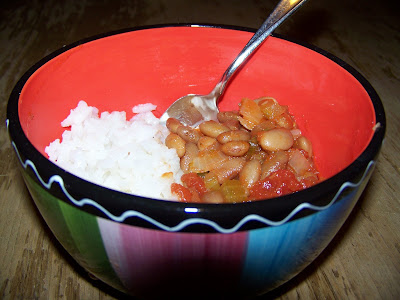 |
| Today's combination: pinto beans, white rice, crushed coriander. |
This is less a recipe than a technique. Beans & Rice is such a staple for me, I make it literally dozens of ways. It depends on what I have in the house. Sometimes it's spicy black beans with brown rice, topped with diced avocado and a squeeze of lime. Sometimes it's red beans with white rice, carrots, and bell peppers, garnished with sliced green onions. Many times I add coconut milk (not today) or finish the dish in the oven (not today).
Today, I had dried pinto beans, Arborio rice, onion, celery, garlic, and a can of tomatoes. If I had had them, I would have added carrots, which make any bean dish sweeter and more colorful. But I didn't. So I worked with what I had. (There is a life-lesson in this, methinks. But this is a cooking blog, so I will leave you to your own reflections.)
I always have vegetable stock and a variety of spices in the house. And as long as I have some aromatics (at least an onion), some beans (canned or dried), and some kind of rice, I can make this--without having to grocery shop!--in almost no time. It's cheap, delicious, filling, and healthy. You can eat it as is, stuff it into tortillas, or use it as a dip for corn chips.
With dried beans, it takes a couple of hours to make Beans & Rice. With canned beans, I can make it in 40 minutes.
Beans & Rice, Today's Way
The key to a good Beans & Rice dish is the seasoning. Especially if you're using dried beans (which I recommend, if you have the time), you need to add quite a bit of salt. Lots of black pepper and crushed red pepper flakes. Cumin, oregano. And here, the star seasoning is crushed coriander seeds.
I don't bother soaking dried beans anymore; I just cook 'em until they're done. But you can soak yours if you want. It will cut the cooking time a bit.
2 cups gluten-free vegetable stock
1 cup Arborio rice (or whatever rice you have)
1/2 lb dried pinto beans
1 tsbp vegetable oil
1 onion, chopped
5 celery stalks, chopped
2 cloves garlic, minced
2 tsp coriander seeds, crushed in a mortar and pestle
1 tsp dried cumin
1/4 tsp crushed red pepper (more or less to taste)
at least 2 tsp salt, plus more for cooking the beans, and lots of black pepper (to taste)
1 14-oz can whole or diced tomatoes, with juice
Cook the rice, using half of the vegetable stock, in your usual way. (I use less water than most package instructions recommend; I like my rice al dente, not mushy.)
Cover the beans with several inches of water and bring to a boil. Reduce the heat, partially cover, and cook until tender, about 1 hour to 90 minutes. Add a huge scoop of salt near the end--I use probably a tablespoon. Taste a bean every now and then to ensure you don't overcook them. Mushy beans are not good beans.
When the beans are nearly done, heat the oil in a cast-iron pot (I use a Le Creuset) or large skillet with deep sides. The heat should be medium-high. Add the onions and celery and saute, stirring, for about 8 minutes, or until tender and translucent. Add a heaping teaspoon of salt and some pepper. Then add the garlic and stir for another minute. Add the crushed coriander seeds, cumin, crushed red pepper, and some more salt and pepper, and stir for 30 seconds or so. Things should smell very fragrant!
Add the tomatoes, breaking them up with a wooden spoon right in the pot if they are whole. Add the beans and, if things look too dry, a little bit of the water you cooked the beans in. Or add more stock. Stir everything well, lower the heat, and simmer for 30 minutes or until--as they say--the "flavors marry." Taste, and adjust the seasoning (you will likely need to add more salt).
By now your rice should be done. Serve the soupy beans over the rice, and eat them up.























